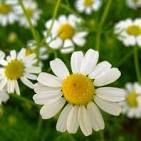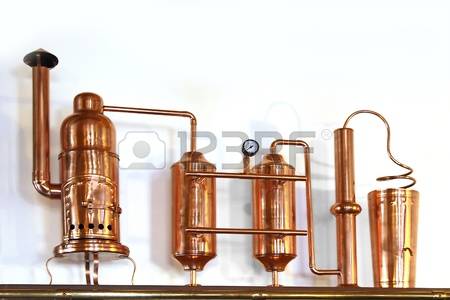Chamaemelum nobile/Roman Chamomile - pH 3.0-3,3













Chamaemelum nobile/Roman Chamomile - pH 3.0-3,3
Aroma and Taste
Extremely sweet, honey like aroma and tasre .Even more apple overtones than the oil has but softer, more delicate. occasionally it will have a greener, more haylike aroma, but this appears to be a consequence of the distillation parameters and to me indicates an inferior product.
Stability and Shelf Life
Very stable, easily lasts for two years or more, although it is do popular the stock rarely lasts that long. I have some chamomile that is four years old and still quite fine.
Properties and Applications
One of the best all-purpose waters, right up there with lavender and melissa.Roman chamomile is the number-one choice for baby care. It can safely be used right from birth, in bath water and as a soothing mist for bedding. Mothers can use it diluted to wash the breast area in addition to help sore and cracked nipples, its calming properties will make feeding time even more relaxing.
Babies will soon associate the aroma of chamomile with Mummy and yummy. When child care is required, the handover is easier if the caregiver uses chamomile as well, as the child will feel that mother is near. Diaper-rash redness and pain can be soothed with dilute chamomile, or use neat applications of a 50:50 blend of Roman chamomile and lavender waters to compress the tender skin. New mothers can use it in compress or a sitz bath for postpartum relief. Homemade wet wipes for babies and young children should always include chamomile.
When teething starts, add two or three drops to a bottle of water to help calm the diarrhea and stomach upset. Rub the gums with diluted chamomile frequently to reduce inflammation, swelling, and pain to help soothe the associated crankiness.
Children adore the flavour of sweet chamomile and will soon ask for it as they recognize the relief it brings. Spritzing a light mist over the blankets or in the air of the child's room will help children sleep.
Because of its effect on the nervous system, chamomile is a useful aid in stress reduction, depression, relaxation, insomnia, and aggravation.
Combine it with melissa or one of the tree waters if alertness is required and to help calm road rage. It can be mildly euphoric, instilling a feeling of well- being.Use as a bedtime tea or bath for reducing stress, for physical relaxation, and for a restful night.
Chamomile is wonderful for skin care,for calming rashes, sensitivities, rosacea, acne, heat rash, and redness. Use it like lavender for burns and sunburns. It is the best all-in-one makeup remover, skin cleanser and toner,
Chamomile is fairly astringent owing to its very acid pH;do not use singly or long-term on very dry skin, windburn, or similar conditions.
Combined with neroli it is good for acenic conditions and oily skin; combine it with witch hazel for mature skin and with lavender or geranium for very dry skin.
Roman chamomile is one of the only four hydrosols recommended as an eyewash, with Geranium chamomile, cornflower, and green myrtle being the others.Compress eyes and wash them frequently with this and/or German chamomile for conjunctivitis. It is a good daily eye wash for soothing the effects of pollution, computer burn and general redness.
Its very low pH makes chamomile a suitable addition to a douche or bidet, and it will calm itching and noninfectious inflammations. It can also be used in combination with oregano or savory hydrosols in treating vaginitis and thrush. men will find it useful for jock itch and general hygiene.
Pets, like babies, can derive great benefits from chamomile, which can reduce stress before travel, after a fight, during a storm, or even when visiting the vet. Teething, espically in puppies,can be as much of an ordeal for owners as for pets; use the same treatment for teething animals as you would for teething babies.
Basically, Roman chamomile is a must-have hydrosol.
Reference: Hydrosols-Suzanne Catty
Centaurea cyanus/Cornflower/Bachelor's Button-pH 4.7-5.0














Centaurea cyanus/Cornflower/Bachelor's Button-pH 4.7-5.0
Aroma and Taste
An extremely delicate scent.
When the hydrosol is cold , the odour is almost undetectable; warm, it becomes vaguely floral.
The flavour undiluted is also delicate, a little green not particularly floral nor herbal, with a slightly bitter after taste but nothing unpleasant.
Diluted, the flavour almost disappears, and one smells more than tastes it.
Stability and Shelf Life
Unstable to moderately stable; shelf life twelve months.
Properties and Applications
Almost interchangable with sandalwood hydrosol in topical treatments of skin conditions.
One of only four hydrosols recommended as an eyewash (ther other three are Roman and German chamomile and green myrtle).
This probably has the widest application as an eyedrop substitute, and users who wear contact lenses say it works very well for them, although it should probably not be used while the lenses are in the eye.
Topically, use cornflower as a compress for tired, swollen, or itchy eyes or for the effects of pollution or long hours on the computer.
Renowned for its cosmetic applications and cool feeling on the skin, cornflower is used to tone crepey skin and firm delicate and mature skin of the decollete.
It is also wonderful for dry and devitalized skin and can be added to masks, lotions, creams, toners, and makeup removers or used on its own before the application of moisturizer.
Combine with rose geranium to combat very dry climates, on airplanes, or to give a dewy complexion.
Daily compresses on the eye area, particularly when combined with rock rose, will visibly diminish fine lines and tone the tissue.
Combine with witchazel or lavender for cleansing cuts and wounds and compressing bruises.
Cornflower is a good choice for diluting shampoos and conditioners or massaging into the scalp;it gives hair shine and highlights, and is less drying than chamomile for blond hair.
A general system tonic, cornflower was once used as a tea against the plague. Why, I don't know, except that plague victims probably tried everything.
Mildly diuretic and digestive, its bitter principals make it supportive to the liver and gently astringent.
On its own or in combination with juniper, cypress, or tea tree, it makes an effective douche for urinary tract infections and is gentle enough not to irritate sensitive tissue.
Internally and topically it can be used to reduce fever, particularly in infants, as its delicate odor is well tolerated.
Research indicates that it may contain phytohormones, and it is certainly worth trying for hot flashes, both topically and internally.
AVOID
During first trimester of pregnancy because of potential presence of phytohormones.
Reference: The Next Aromatherapy- Suzanne Catty
Cedrus atlantical/Cedarwood/Atlas Cedar-pH 4.1- 4.2













Cedrus atlantical/Cedarwood/Atlas Cedar-pH 4.1- 4.2
Aroma & Taste
A light fragrance, dry, woody almost sawdustlike, with sweet overtones. Reminds one of a cold sauna or cedar closet, although these are usually made from the wood of North American Cedar(Thuja sp.), not the mountain or Mediterranean cedar( Cedrus sp.), Quite different from the pervasive aroma of the oil.
Stability and Shelf Life
The odor begins to diminish after eighteen months, but the properties seen to be consistent up to two years or more, depending on the source.
Properties and Applications
This hydrosol is primarly used for topical applications. I do not recommend it for internal use except for specific pathologies, as it is extremely diuretic.
Cedarwood is the first choice for hair care. It has been used successfully as a treatment for thinning hair, some type of hair loss, scalp itch, and dandruff and to add shine and lustre to dry, damaged or treated hair.
The french use it to soften and detangle hair as well as for dandruff.
Shampoos can be diluted by 50 percent with the hydrosol, and conditioners by 30 percent or more.
Cedar blends very well with rosemary CT cineole (for all hair colors) and both sage( for red and dark hair) and chamomile (for blond hair), although sage can easily overpower the cedar aroma.
This is also the hydrosol for animal fur. Its delicate aroma makes it well suited to use on cats to get rid of dander and help deter fleas, and it certainly makes them shiny and sweet smelling.
Use it in a spray bottle and add two or three drops of cedar oil for daily flea spray in summer and autumn.
Dogs seem to have a predilection for certain smells and cedar is one of them.
Some Skin conditions respond well to cedar, particularly weeping and crac ked skin, some types of psoriasis, peeling and sweaty feet, dermatitis, allergic rashes, chicken pox, cold sores and inflamed acne.
Usually compresses of the straight hydrosol , or strong dilution to 50 to 70 percent hydrosol and cool springwater, are the best option in treating skin. Cedarwood also combined well with yarrow hydrosol if intense itiching acompanies the condition.
This hydrosol is wonderful in the bath, especially cool summer baths when the humidity is high. I put it in a kiddie pool and both my dog and I emerge greatly refreshed. Try it in the sauna; it is safe to sprinkle it directly on the rocks and it will help release mucus and phlegm from the lungs, or use it in a foot soak for tired hot feet after you've been standing all day long.
Reference: Hydrosols/The Next Aromatherapy: Suzanne Catty
Hydrosols -The PH - Anomalies










Hydrosols -The PH - Anomalies
On the other hand, some waters with a pH over 5.0 do have long lives. myrtus communis, specifically the high-altitude green myrtle, is quite stable, even though it is 5.7 to 6.0 pH(l'arom atherapie exactment lists myrtle at 3.95 pH). Is this because of its chemistry?
Unlikely, since the high-altitude myrtle is a cineole-rich plant and the cineole-rich hydrosols tend to have shorter life spans.Is it because of the growing conditions at this higher altitude? Perhaps, as high-mountain lavender has a much lower pH than midaltitude lavender.
But there are no confirmed answers yet, I'm afraid, just lots ofm ideas, and this is the kind of thing that I hope will be answered by research in the next couple of years. Good thing, too, that gren myrtle lasts so well, since this is one of the only four waters that is recommended for use in the eyes.
Shock, horror?! Yes, some people actually put hydrosols in their eyes,just like a saline solution or eyedrops, and they are lovely to use in this manner. Look in the momographs section for more information on this subject.
Lavender our precious stalwart, has a pH of 5.6 to 5.9, and as low as 4.5 from the wild highland varieties, yet it will sit on the shelf for two years without a problem-that is, if your supply lasts that long. As interests in hydrosols grows, more and more people are experimenting, but nearly everyone starts with lavender, since they know it so well.
I can barely keep enough in stock to get me from season to season these days, and although I still think the French true lavender water is the best, my Canadian distiller produces a lovely product, and I may need to add Calfornian production to my inventory if demand keeps growing.
(Until now the U.S.-Canadian exchange rate has tendered this product rather expensive by comparison.) But here we enter the sticky world of botanical specificity and the chemical analysis.
My French hydrosol and oil both come from the same producer. It is true organic French Lavendula angustifolia, and Iv'e seen where it grows and where and by whom it is distilled. I have had the oil analyzed, and as the oil and water batch numbers agree, I can be sure that the therapeutic parameters are within the desired range.
My Canadian distiller also provides analysis of the oil that comes with the hydrosol, and although it doesn't grow at one thousand meters above sea level, it, too, fits within the desired parameters when chemically analysed.
This is really what you want when you buy a hydrosol. It is a co-product of essential-oil production, and if you want to know that truly therapeutic oil was produced so you can feel certain that the properties of the hydrosol are also therapeutic. It's not just a smell thing. And I still believe that you get a better hydrosol if the distillation produces oil rather than just water, assuming the plant produces oil.
It has been mentioned several times that botanical specificity is absolutely necessary for essential-oil production, or for any plant being grown for therapeutic applications. Even then, the chemistry of the plant changes and your active ingredients will be more variable from year to year and from producer to producer.
That is the argument for standardized extracts, at least on the surface. Until the day comes when labs can assess hydrosols by GCMS (gas chromatography, mass spectrometry) as easily as oils, we must rely on this cross-referencing system when we buy our waters. For the moment no one is offering analysis of hydrosols, but a project is underway that I hope will soon change this situation.
However, I have digressed wildly. Back to the stability issue. As I said, 5.0 pH seems to be the point at which the shelf life of a hydrosol starts to change; more acid than that and you have a longer shelf life. Why is this?
Reference: Hydrosols - The Next Aromatherapy: SuzanneCatty
Articles - Most Read
- Home
- What are Hydrosols
- What are Hydrosols-2
- The Monographs
- How to Make a Hydrosol
- Table of Common Latin Names and pH Values - F - O
- Distilled or Extracted Specifically For Therapeutic Use - 3
- Kurt Schnaubelt
- What isn't a Hydrosol?
- Table of Common Latin Names and pH Values - P - S
- Wholly Water!
- Blue Babies
- Supply and Demands
- Mature Skin
- Recipes Alpha F
- Hydrosols In The Marketplace
- Chemicals: Friends or Foes?
- Hemorrhoids
- Water as Medicine
- Nelly GrosJean
- The Educated Consumer
- Genitically Modified Plants
- Influences
- Water Quality
Articles-latest
- Daucus carota/Wild Carrot Seed - pH 3.8-4.0
- Cupressus sempervirens/ Cypress-pH3.5-3.7
- Coriandrum sativum/Coriander Herb-and-Seed
- Comptonia peregrinal/Sweet Fern- pH 3.8
- Citrus clementine (fe) Clementine Petitgrain- pH 4.3-4.4
- Citrus aurantium var. amara (flos) /Neroli Orange Blossom-pH3.8-4.5
- Cistus ladaniferus/Rock Rose-pH 2.9-3.1
- Cinnamomum zeylanicum (ec) Cinnamon Bark-pH3.3
- Chamaemelum nobile/Roman Chamomile - pH 3.0-3,3
- Centaurea cyanus/Cornflower/Bachelor's Button-pH 4.7-5.0
- Cedrus atlantical/Cedarwood/Atlas Cedar-pH 4.1- 4.2
- Hydrosols -The PH - Anomalies
- Hydrosols- Establishing Shelf Life and Stability
- Boswellia carterii/FRANKINCENSE
- Asarum canadense/ Wild Ginger/Canadian Ginger
- Artemesia vulgaris / Artemesia
- ARTEMESIA DRACUNCULUS - TARRAGON
- Angelica archangelica / Angelica Root - Hydrosols
- The Key, or More Correctly, the pH - 2 - Hydrosols
- The Key, or More Correctly, the pH-Hydrosols
- The Hard pHacts - Hydrosols
- Calamus Root/Sweet Flag - ACORUS CALAMUS
- Yarrow - Achillea millefolium - Hydrosols
- Balsam Fir - Abies balsamea - Hydrosols

